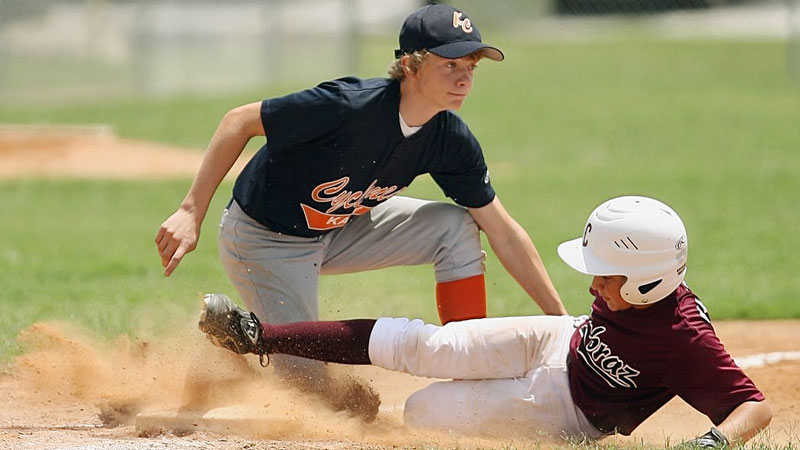Baseball often hailed as America’s pastime, is a sport filled with intricate rules and unique plays that add to its charm and excitement. One such play that can alter the course of a game is the passed ball.
In this phenomenon, the catcher fails to catch or hold onto a pitch that should have been handled with ordinary effort, resulting in the advancement of baserunners.
Passed balls have their distinct definition and scoring criteria, setting them apart from errors and wild pitches. The impact of passed balls on game strategy, player responsibilities, and defensive adjustments is crucial to comprehending the dynamics of the sport.
This article delves into the nuances of passed balls, exploring their definition, consequences, attribution, and notable moments in baseball history.
What Is A Pass Ball In Baseball?
In baseball, a passed ball is a defensive misplay by the catcher that allows a baserunner or baserunner to advance one or more bases. It occurs when the catcher fails to successfully handle a pitch that he should have been able to handle with ordinary effort, and as a result, a baserunner advances.
The specific situations in which a passed ball can occur include:
Pitch in the Dirt
If a pitch is thrown by the pitcher and it bounces in the dirt before reaching the catcher, and the catcher is unable to block it or catch it cleanly, allowing a baserunner to advance, it is considered a passed ball.
Mishandling a Pitch
If a pitch is thrown by the pitcher and the catcher fails to catch or handle it properly, resulting in a baserunner being able to advance, it is considered a passed ball. This can happen when the catcher fails to catch a pitch that is within their reach, or if they drop a catchable pitch.
Overthrow
If the catcher attempts to throw out a baserunner attempting to steal a base or pick off a baserunner but makes an inaccurate throw that results in the ball going into the outfield or another area, allowing the baserunner to advance further, it is considered a passed ball.
It’s important to note that a passed ball is different from a wild pitch. A wild pitch is charged to the pitcher when a pitch is so errant that the catcher has little to no chance of catching it, resulting in a baserunner advancing.
On the other hand, a passed ball is charged to the catcher for a defensive misplay that allows the baserunner to advance, even if the pitch was reasonably catchable.
Passed balls can have consequences in a game, as they can lead to baserunners advancing and potentially scoring runs.
Is Passball An Error in Basketball?
Passball is not an error in baseball. It is a separate statistic that is recorded for catchers and is distinct from errors.
An error, in baseball, is a defensive misplay by a fielder that allows a batter or baserunner to advance or reach a base they would not have reached without the error.
Errors are typically charged to the fielder who made the misplay, such as dropping a catchable ball, making an errant throw, or mishandling a ground ball.
On the other hand, a passed ball is solely charged to the catcher and is not considered an error. It is a defensive misplay specific to catchers that occurs when they fail to successfully handle a pitch that they should have been able to handle with ordinary effort.
The definition and situations in which a passed ball can occur were explained in the previous response. While both errors and passed balls involve defensive miscues, they are treated as separate statistical categories and are recorded and evaluated differently.
Errors are attributed to the fielder who made the mistake and can affect a player’s fielding percentage and overall defensive performance. Passed balls, on the other hand, are solely charged to the catcher and are not factored into a player’s fielding percentage.
How to Avoid Wild Passed Balls?
To minimize the occurrence of wild passed balls in baseball, catchers can focus on several key aspects of their game. Here are some tips to help avoid wild passed balls:
Communication
Establish clear and effective communication with the pitcher. Make sure you are both on the same page regarding pitch selection and location. Develop a system of signals or signs that allows for quick and accurate communication between you and the pitcher.
Proper positioning
Position yourself correctly behind home plate to provide the best possible target for the pitcher. Stay low in a balanced crouch, with your glove out in front of you. This position will make it easier to receive pitches and reduce the chances of them getting past you.
Glove Technique
Focus on using proper glove technique to catch the pitches. Keep your glove relaxed and slightly open, providing a good target for the pitcher. Try to receive the ball softly and “frame” the pitch by catching it smoothly and minimizing unnecessary movements.
Quick reactions
Improve your reaction time by staying alert and anticipating pitches. Be prepared to adjust your body position and move laterally to catch pitches that may be off target. React quickly to pitches in the dirt by getting your body down and blocking the ball with your chest or body.
Blocking techniques
Develop strong blocking skills to prevent pitches in the dirt from getting past you. Practice the proper technique of getting your body in front of the ball and using your chest, legs, and arms to smother the pitch and keep it in front of you.
Focus on keeping the ball within a manageable distance, allowing you to quickly retrieve it if it does get past you.
Practice and repetition
Regular practice is essential to improve your catching skills and reduce the chances of wild passed balls.
Work on receiving different types of pitches, blocking techniques, and refining your overall catching mechanics. The more you practice, the more comfortable and consistent you will become.
Anticipate the pitcher’s repertoire
Study the pitchers you work with regularly and become familiar with their pitch repertoire. Understand their tendencies and how their pitches move.
This knowledge will help you anticipate the trajectory and potential break of each pitch, allowing you to position yourself accordingly and make better catches.
Stay focused and avoid distractions
Concentration is crucial when catching, as even a momentary loss of focus can result in a wild-passed ball. Minimize distractions and stay fully engaged in the game at all times.
Remember that becoming a skilled catcher takes time and practice. By implementing these tips and continuously working on your catching skills, you can significantly reduce the occurrence of wild passed balls and become a more reliable presence behind the plate.
Impact of Pass Ball on Game Strategy
The impact of a passed ball on game strategy can vary depending on the specific situation and the score of the game. Here are a few ways in which a passed ball can influence game strategy:
Baserunning and Aggressiveness
A passed ball presents an opportunity for baserunners to advance. If a runner is on base and a passed ball occurs, they may choose to be more aggressive in attempting to steal the next base or take advantage of the misplay by advancing an extra base.
This can affect the strategic decisions made by both the offense and defense. The offense may be more inclined to attempt steals or hit-and-run plays, while the defense may adjust their strategy to focus on preventing further baserunner advancements.
Pitching Strategy
When a passed ball occurs, the pitcher may need to adjust their strategy. They may choose to focus more on pitching to contact to minimize the chances of additional wild pitches or passed balls occurring.
The pitcher may also communicate with the catcher to ensure they are on the same page regarding pitch selection and location to avoid further defensive miscues.
Defensive Adjustments
The defense, particularly the catcher, may make adjustments after a passed ball. The catcher may pay extra attention to their positioning and technique to prevent further passed balls.
Additionally, the other fielders may become more alert and anticipate potential baserunner advancements, making sure to cover bases or back up throws more effectively to limit the damage caused by the passed ball.
Run-scoring Opportunities
A passed ball can create scoring opportunities for the offense. If there are runners in scoring position and a passed ball occurs, it can allow the baserunners to advance and potentially score runs.
This can significantly impact the offensive strategy, with hitters potentially focusing on making contact or hitting fly balls to drive in the runners.
Psychological Impact
A passed ball can have psychological effects on both teams. For the defensive team, it can lead to frustration or a loss of confidence, while the offensive team may gain confidence and momentum from the extra baserunner advancements.
These psychological factors can influence the overall game strategy, with the offensive team seeking to capitalize on the defensive team’s mistakes and the defensive team striving to regain composure.
A passed ball can impact game strategy by influencing baserunning decisions, pitching strategies, defensive adjustments, run-scoring opportunities, and the psychological dynamics of the game.
It introduces new possibilities and considerations for both teams, potentially altering the flow and tactics employed throughout the remainder of the game.
Notable Passed Ball Moments in Baseball History
Some notable passed-ball moments in baseball history are mentioned in the following phase of this article. Take a close look at them below.
Highlighting Famous Instances of Passed Balls in Significant Games
- World Series Game 4, 1960: In one of the most memorable World Series moments, a passed ball occurred in the bottom of the ninth inning, allowing the winning run to score for the Pittsburgh Pirates against the New York Yankees. The passed ball added to the dramatic finish of the game and cemented its place in baseball lore.
- Game 7, 2001 American League Championship Series: In a crucial game between the New York Yankees and the Seattle Mariners, a passed ball occurred, leading to a run scored by the Yankees.
The play had a significant impact on the outcome of the game and helped propel the Yankees to the World Series. - Game 5, 2017 World Series: In a pivotal moment of the series, a passed ball occurred in extra innings, allowing a runner to score for the Houston Astros against the Los Angeles Dodgers. The passed ball contributed to the Astros’ victory and ultimately played a role in their World Series championship.
Analysis of the Impact and Outcome of These Moments
Notable instances of passed balls in significant games often have a lasting impact on the outcome of the game and the trajectory of the series. They can swing momentum, alter strategies, and create dramatic finishes.
The occurrence of a passed ball introduces an element of unpredictability and adds excitement to the game, as teams scramble to capitalize on the defensive lapse.
Analyzing the impact of these moments involves examining how the passed ball affected the score, the subsequent plays, and the ultimate result of the game.
It highlights the importance of defensive execution and the critical role played by catchers in controlling the game.
The analysis also considers the resilience and ability of teams to capitalize on the opportunities presented by passed balls, showcasing the dynamic nature of baseball and the potential for game-changing moments.
FAQs
Are passed balls considered errors?
No, passed balls are not considered errors. They are separate from errors, which occur when fielders make mistakes on batted or thrown balls. Passed balls are attributed to the catcher when they fail to catch or hold a legally pitched ball that should have been caught with ordinary effort.
Can a runner score from third base on a passed ball?
Yes, if there is a runner on third base and a passed ball occurs, the runner has the opportunity to score. Since the ball gets away from the catcher, the runner can take advantage of the defensive lapse and attempt to advance home.
Can a passed ball be credited as a stolen base?
No, a passed ball is not credited as a stolen base. A stolen base occurs when a baserunner successfully advances to the next base while the pitcher is delivering the pitch or when the catcher attempts to throw out the runner.
A passed ball, on the other hand, involves the failure to catch or hold a pitch by the catcher.
How do pass balls impact a pitcher’s statistics?
Passed balls do not count against a pitcher’s earned run average (ERA) or their statistics. The responsibility for a passed ball typically falls on the catcher.
However, passed balls can indirectly impact a pitcher’s performance if they result in runs scored or affect the pitcher’s confidence or rhythm.
Wrapping Up
Passed balls play a significant role in the dynamics of baseball. They occur when a catcher fails to catch or hold onto a pitch that they should have handled with ordinary effort, leading to the advancement of baserunners.
While not considered errors, passed balls can have a profound impact on the outcome of games, influencing strategy and providing opportunities for runners to score.
The responsibility for a passed ball is typically attributed to the catcher, highlighting the importance of their role in controlling the game. Preventing passed balls requires skill, coordination, and effective communication between pitchers and catchers.
Notable moments in baseball history have been defined by passed balls, showcasing their potential to create dramatic and game-changing situations. Thank you for staying with us.







